"Purr-fect Pet Parenting: Tips, Advice"
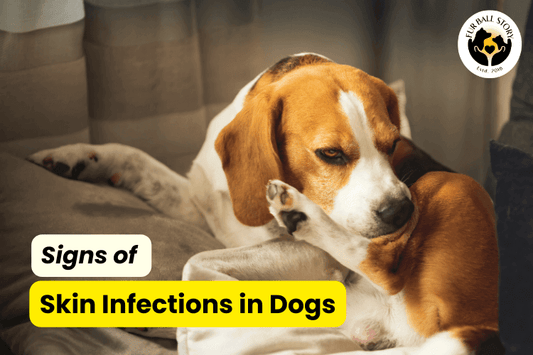
Signs of Skin Infections in Dogs
Skin being the largest organ is highly prone to infections. Skin infections in your pet might go unnoticed until they become a serious problem. Learn about some of the common signs of...
Signs of Skin Infections in Dogs
Skin being the largest organ is highly prone to infections. Skin infections in your pet might go unnoticed until they become a serious problem. Learn about some of the common signs of skin infections in dogs and their remedies. Check out the blog below: 1. Excessive Itching/Licking During a skin infection, there can be three major reasons that are responsible for excessive itching and licking. Firstly, the sensory nerves under skin can become irritated or overstimulated due to a skin infection which causes itching or discomfort. Secondly, to help in faster healing of skin, the immune system releases chemicals that can cause itching. Lastly, dogs have a natural tendency to lick the infected area in order to clean any dirt or bacteria that might be stuck on the site. However, excessive scratching can worsen the situation. So, use an infection relieving cream like Eczo Pet, which is safe because of its natural composition. It helps in rapid healing of the infection and soothes itching. 2. Dandruff Infection hampers the skin's protective barrier. As a result, the moisture escapes easily which causes dryness and flakiness. Certain bacterial and fungal infections like Ringworm can cause damage to the skin shedding of fur. One of the primary symptoms of Hypothyroidism is dry and flaky skin. Use Eczo Pet to relieve the skin infection of your pet. This natural cream for dogs contains no harmful chemicals and relieves skin infection. 3. Discharge from Skin To heal the infected skin, the immune system sends white blood cells and other inflammatory mediators. This causes accumulation of dead cells, bacteria, immune cells forms pus, which fills pustules and causes discharge. Infections caused by bacteria, viruses and fungus can lead to the formation of breakouts that discharge through the skin. Parasites and allergies can cause secondary bacterial infections, which produce discharge. To instantly treat the discharge, use Fur Ball Story’s First Aid Kit for Pets. Firstly, soak betadine solution on a cotton ball and clean the area. Now, apply Eczo Pet contained in this First Aid Kit on the wound. Keep this first aid box at your home as it contains several other medicines that relieve fever, upset stomach, ticks, minor injuries and more. 4. Hair Loss Skin infections cause inflammation and damage of hair follicles responsible for growing hair. This causes hair fall and hampers their growth. Also, the hormonal imbalance and response of immune cells to fight off infection can also damage the follicles, which triggers hair loss. Excessive licking and scratching physically damages the hair follicles which cause hairfall. To prevent hairfall, CanniVin can be given as a secondary treatment option. It is India’s most potent hair supplement for dogs that is enriched with Biotin, DHA, Omega 3, Copper and various other vitamins & minerals that ensure healthy skin and a shiny coat. 5. Excessive hair knots in long haired breeds In long haired breeds, loose fur often gets entangled with the existing fur, creating hair knots. However, during skin infection, the situation might worsen. The inflammation and swelling of skin during an infection can interfere with the production of natural oils, making it prone to dryness and entangling of the fur. Also, the increased moisture and debris in the fur due to infection can lead to knot formation. For regular care of long-haired breeds, Shampooch is one of the best solutions. This dog shampoo is made using natural herbs like lemongrass oil, clove oil and aloe vera to ensure gentle cleansing of the fur and keep the skin healthy. 6. Scaly Skin Infections can cause the shedding of skin cells besides dry and flaky patches. Fungal and Bacterial infections also damage the skin barrier and cause scaly patches. Parasites and allergic reactions might cause secondary bacterial infections that lead to scales on the skin. Early detection and treatment can help in effectively reliving the symptoms. If your dog’s skin generally remains dry and flaky, use Shampooch, a dog shampoo to prevent dandruff, hairfall, foul odour and more. How to treat skin infections in pets? Eczo Pet is a natural cream that helps to relieve skin infections like Eczema, Dermatitis, Mange, Ringworm, Degnala, etc. It also relieves the symptoms such as itching, dryness and outbreaks. This natural cream for dogs and cats is enriched with 100% natural ingredients like Somavalka, Bakuchi and Neem to ensure rapid healing of your dog's skin. Keep an eye on the signs of skin infections in dogs and cats to timely cure any issues before they escalate. Maintain good hygiene practices to prevent such problems. If you notice any symptoms, consult a veterinarian.

Top 5 Popular Dog Breeds in India 2024
India is a land of history blended with modernity. Dogs are worshipped for their companionship and loyalty at several places in the country. From Lord Bhairav to Yamraj The God of Hell, dogs hold prominent importance...
Top 5 Popular Dog Breeds in India 2024
India is a land of history blended with modernity. Dogs are worshipped for their companionship and loyalty at several places in the country. From Lord Bhairav to Yamraj The God of Hell, dogs hold prominent importance in the country. There are temples like Chinnapatna and festivals like Kukur Tihar which are dedicated to celebrating the spirit of dogs. In this blog, explore some of the top dog breeds that have made a special place in the hearts of Indian families. 1. Labrador A perfect combination of playfulness and purpose, Labrador is one of the most common dog breeds seen in Indian households. Labradors gained popularity because of their innate love for families and friendly nature. Their high tolerance and energy make them a beloved breed among children and give them a special status in the Indian Armed Forces. Whether splashing in the water, winning in sports, or being a comforting companion, this breed resonates with happiness and camaraderie. 2. Golden Retriever World’s most cutest dog breed is here! The fluffy sunshine of doggo nation, Golden Retrievers are known to be the cuddle champions. They unleash joy with their soulful eyes and wagging tails while bringing endless love and affection to the lives of people around them. Retrievers are more than just pets, they are pure happiness wrapped in a furry package, making them a popular dog breed in India. 3. German Shepherd German Shepherd stands as a popular choice among dog lovers. In ancient India, only the luxury and elite class of Royals, Landlords or English Officers enjoyed the privilege of keeping them. However, now it is owned by more than 10,000 pet parents nationwide. The furious looking breed is known for its intelligence, obedience, and sensory powers. They are a prominent resource to the police and military forces by serving as search, sniffer and rescue dogs. 4. Shih Tzu ‘Shih Tzu’ meaning ‘Little Lion’ is related to the Tibetan Buddhist God of Learning. They are a bunch of joy and energy that lighten up the lives of people around. Their long, flowing fur and round eyes make them the most lovable breed across the world. Additionally, their easily manageable size makes them suitable for apartments and smaller living spaces. With time, Shih Tzus gained popularity among celebrities and media, which escalated public perception and their demand. 5. Indie Roaming around with thick fur and sharp features, Indies are an epitome of selfless love for Indians. They are one of the oldest dog breeds which have been adorning the Indian subcontinent for over a thousand years. Indies are naturally healthy, adaptable, sociable and intelligent dogs. These indigenous breeds include Pariah Dog, Mudhol, Kanni, Kombai and other breeds of Indian history. They hold a significant part in Indian history and heritage, while carrying forward the local ecosystem. Also check out: Why Should You Adopt An Indie Dog? Can All Dogs Swim? FAQs: Top 5 Popular Dog Breeds in India 2024 What is the most popular dog in India? Labrador has always been India’s most popular dog breed. Always enthusiastic and full of energy, Labrador is a fun-loving breed which makes them a great companion for Indian households. What are the top 5 popular dog breeds? Top 5 Popular Dog Breeds in India 2024 are: Labrador Golden Retriever German Shepherd Shih Tzu Indie Breed What is the most common dog name in India? Tommy, Blacky, Kaalu, Bruno, Champ, Alex, etc are some of the most common dog names in India. People often prefer keeping the name either based on the color of the dog or after something that is relatable to them. Which dog is rare in India? Tangkhul Hui is an Indie dog breed which hails from Manipur. They are among the rarest breeds that are found in India these days. They are known for their hunting skills, high energy levels and endurance.
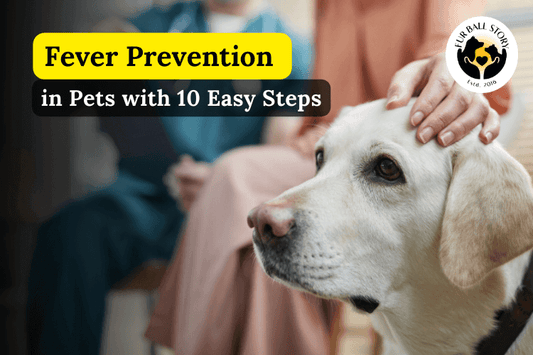
Fever Prevention in Pets: Minimize the Risk of ...
One of the most common health problems faced by pets is fever. Checkout the blog on Fever Prevention in Pets: Minimize the Risk of Fever in Your Pet with 10...
Fever Prevention in Pets: Minimize the Risk of ...
One of the most common health problems faced by pets is fever. Checkout the blog on Fever Prevention in Pets: Minimize the Risk of Fever in Your Pet with 10 Easy Steps to understand how you can keep your fur baby happy and healthy. 1. Avoid Extreme Temperatures Providing a comfortable temperature to your pet is a must. Extremely high or low temperatures can be harmful to dogs. It makes them prone to fever due as the heat keeps accumulating in their body. So, avoid exposing your pet for longer periods in the heat. Be extra cautious as the weather changes as it can trigger fever problems in dogs. Avoid extreme temperatures like excess heat or cold. 2. Keep Allergens Away Allergy might cause fever as one of the symptoms. It is important to identify the substance which your dog might be allergic to and ensure protection against such allergens. These allergens can include pollen grains, dust, perfumes, or cigarette smoke. Also, dogs can be allergic to food items such as dairy products, grains, wheat or meat. Observe your dog to know which item is causing the allergy. Consult a veterinarian to understand your dog’s individual needs. 3. Balanced Diet Low immunity can cause recurring infections as it makes your dog prone to diseases. This causes frequent fever in them. Follow a healthy diet plan and practice weight management to avoid this condition and diseases like obesity, anemia, liver damage. Consider feeding your dog boiled rice, chicken, eggs, plain boiled daal, seasonal fruits and vegetables. You can boost the nutritional value of food by topping it with health supplements like CanniVin Multivitamin Spray. Besides enhancing immunity, it also supports essential life mechanisms like metabolism, energy production, organ function and more. 4. Timely Deworming If your pet catches stomach worms, it can damage their internal organs and cause fever apart from upset stomach, indigestion, vomiting and diarrhea. Thus, deworming your pet is important. Ensure deworming after every 3 months to prevent the buildup of worms. You can use natural deworming tablets like Worm No More to ensure natural protection from stomach worms. It is India’s First Ayurvedic deworming tablet for pets that has no side effects. 5. Careful Socialization Socialization can be indirectly responsible for causing fever in dogs. When taking your pet out for walks or in parks, be careful about socializing them. There might be dogs around who have communicable diseases such as Canine Flu, Canine Distemper, Parvovirus, or infections. Protecting your pet against any such disease is highly crucial. This does not mean confining your dog to staying at home and completely restricting their exposure. Just take precautions by cleaning their paws and washing your hands after every outing to prevent the spread of such diseases. 6. Avoid Toxic Food Food items like grapes, onion, garlic, chocolates, caffeine, avocado, are safe for humans but unsafe for our furry friends. They cause toxicity, affect stomach, kidney, and central nervous system of dogs. Also, sugary substances like gums, candies, and baked goods cause insulin release and lead to liver failure in dogs. It has also been observed that most dogs are lactose intolerant, which means avoiding dairy products that might be toxic to your pet. In all these cases, fever is generally a secondary symptom whereas the primary effect is toxicity caused by ingested food. Thus, it is recommended to keep away any such food item from your pet. 7. Minimize Stress Dogs can face stress and anxiety due to various factors such as thunderstorms, loud music, motion sickness, separation anxiety and so on. Managing stress is essential to improve the overall health and immune function of pets. It minimizes the risk of infections and fever. Provide a stable environment to your pet while addressing the behavioral issues to prevent fever in your dog. If you see your pet often being stressed out, Calm Pet is a natural dog medicine that can resolve this problem. This anti-anxiety tablet for dogs reduces stress, enhances immunity and improves sleep cycle. 8. Prevent Ticks Tick Fever arises when your dog’s immune system fails to eliminate the protozoa transmitted by ticks. Besides fever, ticks can also cause symptoms such as nasal bleeding, vision problems, neurological disorders, limping, respiratory distress, or weight loss. So, tick prevention is important to prevent tick fever. Tick Free is a natural spray to prevent ticks in pets. It helps in easy removal of ticks while also preventing ticks from attaching the fur of your pet. 9. Enhance Immunity Dogs with a strong immune system are less likely to catch infections that induce fever. A strong immune system can easily fight off viruses and bacteria before they cause infections that lead to fever. To enhance your pet’s immunity, consider regular exercises and a balanced diet. Top up their meal with Supertonic Syrup to boost the nutritional value of regular diet and provide your pooch with essential vitamins and minerals. This 100% natural syrup for dogs contains giloy, amla, ashwagandha and more such ingredients that not only enhances their immunity, but also ensures their physical and mental fitness. 10. Regular Veterinary Checkup By conducting a physical examination, a veterinarian will be able to identify if your dog has any underlying health problem. This also includes up-to-date vaccinations to reduce the risk of contracting illnesses. Some chronic diseases can also lead to recurring fever. So with these regular veterinary checkups, you can responsibly monitor your pet's health and detect the early signs of these conditions. To keep your pet protected from fever, Fev Pet Syrup is a trusted choice with 100% natural ingredients. By implementing the above-mentioned strategies, provide them the love and care they deserve. With a balanced diet, exercise, a stress-free environment and regular veterinary check-ups, you can reduce the risk of fever and keep your pooch healthy and happy.
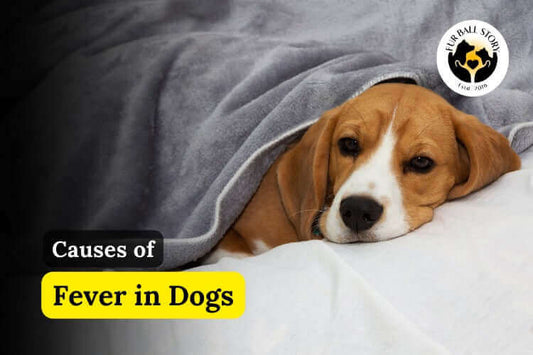
Causes of Fever in Dogs
Wondering what can cause a high temperature in dogs? Here are some of the causes of fever in dogs. Check out the blog below to know the causes and treatment...
Causes of Fever in Dogs
Wondering what can cause a high temperature in dogs? Here are some of the causes of fever in dogs. Check out the blog below to know the causes and treatment options for fever pets. 1. Infections Various bacteria, viruses, fungus and parasites can enter the body and damage the tissues, leading to infection. To fight off these harmful organisms, the immune system activates and become one of the reasons for dog temperature rise. These pathogens can attack anywhere in the body, such as the lungs causing pneumonia. Depending on the site of attack, infection can be in the form of tooth abscess, bite, scratch or cut, infection of urinary tract, ear, kidney, brain, or even skin. Enhance the defense mechanism of your pet naturally with Supertonic Syrup. 2. Ingestion of Toxins Toxicity can also be among the causes of fever in dogs. Be watchful of what you feed to your dog or what they might ingest from the surroundings. Substances like chocolate, onion or nuts that are human-friendly, but can be poisonous to your dog. It can show side effects like increased heating of the body, vomiting, diarrhea, difficulty breathing or neurological reactions. To avoid such accidents, keep any such substances out of reach of your pet. 3. Heat Stroke Body releases heat through panting and dilating blood vessels to maintain normal dog temperature of 101.0 to 102.5°F. When exposed to extreme heat, the chances of heatstroke or overheating increase because these mechanisms fail to expel the extra heat. So, prolonged exposure to heat leads to an accumulation of heat within the body, causing high temperature in dogs. To prevent heatstroke, do not expose your pet for longer periods in the heat or never leave them in parked cars. In summers, you can ensure heat protection naturally with Cool Pet. 4. Stress or Anxiety Similar to humans, the nervous system of dogs responds to stress and anxiety with an increased heart rate. In response to fight or flight situations, the body activates the nervous system to deal with threats by releasing stress hormones. This redirects the blood flow away from skin towards other organs like heart and muscles. It leaves behind a heat or warm sensation in the body. Help your dog calm down by simply petting them or using natural stress remedies for dogs like Calm Pet to manage stress hormones. 5. Medication or Vaccination Some medicines such as immunosuppressants, that are used to treat autoimmune disorders, might lower the ability to fight against infections. As a side effect, these infections can cause fever. Moreover, it is normal to witness a low-grade fever for 24 to 48 hours after vaccination as a response to the injected antibodies. Since the immune system is being stimulated to fight against diseases, the body raises its temperature. 6. Autoimmune Disorders In autoimmune diseases, the immune system targets special cells or proteins by producing auto-antibodies. It triggers immune response and releases inflammatory hormones, causing fever as dog illness symptoms. To balance your pet’s immunity, Supertonic Syrup is the natural aid. With the benefits of herbs like Ashwagandha and Giloy, it helps in maintaining the health of multiple organs such liver, kidney, and the gut. 7. Inflammatory Conditions Inflammation of joints, skin, digestive tract, ear canal, or pancreas occurs because of cell or tissue damage. This leads to release of additional immune cells, which further contributes to fever. In conditions such as pancreatitis, inflammatory bowel disease, or arthritis, one of the symptoms can be fever while others may include indigestion, neurological disturbance, behavioral changes, etc. In case of inflammation or pain in joints, provide your pet natural joint pain relief with Jump-O-Joint Duo. 8. Metabolic Disorders When the metabolic system fails to flush out toxins, it can hamper the functioning of organs such as liver, pancreas, and kidneys. These toxins, metabolic by-products, and inflammatory mediators keep accumulating in the bloodstream. It triggers the body temperature because toxins flow through the bloodstream throughout the body. Dysregulation of hormones such as thyroid hormones, cortisol, etc. can hamper the body's ability to maintain normal dog temperature. FAQs: Causes of Fever in Dogs How to check dog fever with a thermometer? If you are wondering how to reduce dog fever, you all need is a digital thermometer. Start by lubricating the thermometer with baby oil or petroleum jelly. Place the thermometer about 1 inch into your dog’s anus till you get the result. What can I give my dog for a fever home remedy? Home care for dog fever requires natural dog fever treatments such as Fev Pet. It is a dog fever medication that relieves symptoms of canine fever such as high temperature, cough, cold and body pain due to fever. How long does dog fever last? Fever in dogs might last for 2-3 days. However, depending on the cause of fever in dogs and your dog’s ability to fight off disease, the time duration might vary. Does a dog's temperature go up when in heat? Yes, when exposed to heat for a longer period, the chances of heatstroke or overheating increase. The accumulation of heat within the body causes high temperature in dogs.
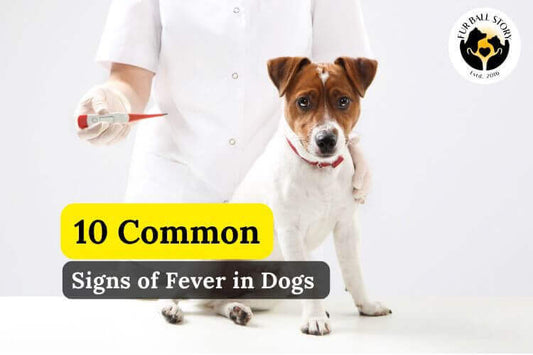
10 Common Signs of Fever in Dogs
A dog’s normal body temperature ranges from 101° to 102.5°F, while a temperature more than 103° F is considered as fever. Pets can experience fever as a symptom of various...
10 Common Signs of Fever in Dogs
A dog’s normal body temperature ranges from 101° to 102.5°F, while a temperature more than 103° F is considered as fever. Pets can experience fever as a symptom of various underlying health issues. Thus, recognizing 10 Common Signs of Fever in Dogs is important for timely treatment. Here are the signs that your pet might have a fever, along with cause and treatment for each: 1. Warm/Hot Ears & Paws Increased blood flow to ears and paws usually leads to a higher than usual temperature. Use a rectal thermometer to accurately measure your pet's temperature. Moreover, Fev Pet is one of the best Dog fever home remedies to treat fever in pets besides relieving body pain, cough or cold accompanied due to fever. 2. Behavioural Changes As the body redirects energy towards fighting infection, fever can be witnessed. So, lack of energy causes weakness, fatigue, increased sleepiness, restlessness, irritability, anxiousness or lesser engagement in usual activities. Provide your pet a quiet and comfortable space to rest and encourage more hydration. Supertonic Syrup can be given to dogs witnessing lethargy, weakness and improve the health of kidney, liver, gut and other organs. 3. Loss of Appetite Fever lowers the appetite as the body focuses on combating the illness rather than digestion. General discomfort experienced due to fever can also cause temporary changes in eating habits. Offer small and easily digestible meals or go for hydrating foods such as coconut water, plain chicken soup or boiled daal to ensure extra nutrition. Loss of appetite or indigestion issues such as gassy stomach, vomiting, diahorrea can be relieved using Pacho Pet, which is a natural medicine for indigestion in dogs and cats. 4. Shivering or Trembling Just like humans experience chills during fever, similarly, pets may shiver or tremble during fever. In this way, the body attempts to generate additional heat. Thus, keep your pet warm with blankets while avoiding overheating. Monitor the changes in temperature using a thermometer. 5. Increased Heart Rate Fever can elevate the heart rate as the body tries to circulate blood more efficiently to combat the underlying cause of the fever. Measure the heart rate and consult a veterinarian if the readings are consistently abnormal. 6. Coughing or Sneezing Symptoms such as coughing or sneezing often accompany fever. They might indicate respiratory infection or illness. Monitor these signs closely and consult your vet for appropriate treatment. Fev Pet is a natural fever medicine for dogs and cats that helps in lowering down the body temperature as well as relieves cough, cold, body pain or any other symptom. 7. Nasal Discharge Fever can cause nasal passage to produce excessive mucus, which can range from clear to coloured depending on the cause. It indicates that the respiratory system is involved to cope up with the underlying cause of fever. Keep the nasal passage clean and consult your veterinarian if the issue persists for several days. 8. Dry/Warm Nose Tip Nose can be dry or warm because of dehydration when the body is redirecting fluids to combat fever. In that case, ensure your pet has access to fresh water and feed them hydrating foods such as coconut water, yogurt, or bone broth. To relieve dryness of nose tip, Cool Pet can be applied to the snout area and paws. It does not allow heat from the ground to affect your pet and keeps them protected from heat stroke. 9. Hyperventilation Depending upon the cause, some dogs might experience hyperventilation during fever. The body attempts to expel heat or and cope with infection by the means of rapid or shallow breathing. Use a wet towel or ice pack to bring down the fever gradually and help them calm down. 10. Excessive Salivation Some pets may drool more than usual when they have a fever. It is nothing but a response to feeling unwell or dehydrated. Tackle this problem by ensuring appropriate hydration. If the issue continues to persist, connect with your veterinarian. Wondering how to treat the symptoms fever in pets? Don't worry, we have got you covered with Fev Pet. It is a natural remedy to treat fever at home. If you suspect your pet has a fever, it's essential to address the underlying cause and provide them relief promptly using Fev Pet. Consult a veterinary doctor for a thorough examination and appropriate treatment based on the cause. Early detection and treatment can significantly improve the recovery rate. FAQs About 10 Common Signs of Fever in Dogs How to detect fever in dogs? The most accurate way to detect fever is by using a digital thermometer. Lubricate the thermometer with petroleum jelly or baby oil and then gently place it about 1 inch into your dog’s anus. How long does dog fever last? Depending on the reasons for your dog's temperature rise, fever can last for more than 24 hours. It is recommended to take dog-friendly fever medicines like Fev Pet to relieve fever and its signs. Can dogs recover from fever without treatment? With appropriate Home care for dog fever, you can relieve the condition of your pet. This includes Fev Pet, which provides a natural relief to fever, cough, cold and body pain due to fever. What should I do if my dog has a fever? To relieve fever in pets, Fev Pet is the best dog fever medication. This natural remedy targets the root cause of fever while helping your pet to fight against the viral infection.
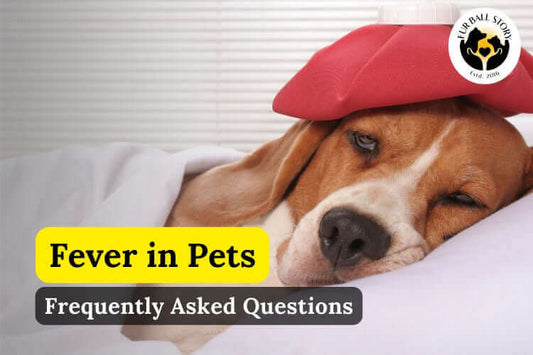
Frequently Asked Questions About Fever in Dogs
Fever in dogs can be concerning for any pet parent. Understanding about its causes, signs and symptoms is crucial to ensure your furry friend's well-being. This comprehensive guide aims to answer all your burning...
Frequently Asked Questions About Fever in Dogs
Fever in dogs can be concerning for any pet parent. Understanding about its causes, signs and symptoms is crucial to ensure your furry friend's well-being. This comprehensive guide aims to answer all your burning questions about canine fever. So, let's crack these common yet often misunderstood aspects of your pet's health. How can I tell if my dog has a fever? Keep an eye on the symptoms of fever in dogs such as: Red eyes Warm ears/nose/paws Loss of appetite Shivering Increased heart rate Runny nose Coughing or sneezing Dry nose tip Hyperventilation/difficulty breathing Excessive Salivation If you suspect fever, check using a digital thermometer and consult a veterinarian if temperature ranges more than 103°F. What is the normal body temperature of dogs? The normal dog temperature ranges from 101.0°F to 102.5°F which is 38.3 to 39.2°C. So, any temperature higher than the given range is considered as fever accompanied by the symptoms can be a sign of fever. However, it is not always true as the temperature can be 103°F if a dog is excited or stressed; monitor other symptoms in that case. How to check fever in dogs? The most accurate way to check your dog’s temperature is by using a digital thermometer. Firstly, lubricate the thermometer with petroleum jelly or baby oil. Now gently insert the thermometer about 1 inch into your dog’s anus. It will take less than 60 seconds to get the results. Is paracetamol safe for dogs? Never give your dog any human medicines as they can be poisonous to dogs and cause severe injury or death. Alternatively, you can use fever medicine for dogs such as Fev Pet. It is a careful combination of herbs that is developed by a team of experienced professionals, veterinarians, researchers, and animal health experts to relieve fever and its symptoms in pets. What natural remedy can you give a dog for a fever? Encourage hydration with small amounts of water on a regular basis. If your dog has a temperature above 105 F, you can apply cool water to their fur, especially around the ears and feet. Be sure to monitor the temperature alongside and stop the cooling process once the temperature drops to 103°F. Keep them under a fan to provide a comfortable temperature that is neither too hot nor too cold. Are dogs cool at night and hot during the day? A dog’s temperature can vary throughout the day or at night. Therefore, determine your dog’s regular temperature by noting their body temperature at various times of the day, for a few days until you get the readings verified. What food can we give to dogs with fever? Coconut water, plain chicken soup, boiled daal can be your go to options as they hydrate as well as ensure nutrient supply to the body. Remember, your dog might not feel the urge to eat anything when they are down with fever. It thus becomes crucial to ensure that appropriate nutrition is provided to help them fight off the disease. What are the causes of fever in dogs? There can be several causes of dog fever, such as: Bacterial, fungal or viral infection Ear infection Infected wound Tooth infection Urinary tract infection Ingestion of poisonous materials Stress or anxiety Brain tumour Tick-borne disease Apart from this, high temperatures during summer can cause Hyperthermia or Heat stroke. To prevent heat stroke in pets, use Cool Pet on their paws, belly, nose and heat-prone areas. As we wrap up, it is important to remember that while fevers can be concerning, they are often signs that the body is fighting off an infection or dealing with inflammation. Fev Pet can be given as a secondary treatment option, however, it is always best to consult your veterinarian. Stay informed and keep your furry friend healthy and happy!
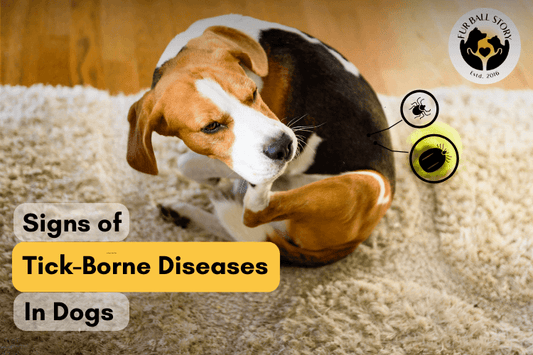
Signs of Tick-Borne Diseases in Dogs
Tick-borne diseases can be a serious health risk to your dog. This blog helps you know how to identify if your dog has a tick-borne disease. Learn about the most common Signs of...
Signs of Tick-Borne Diseases in Dogs
Tick-borne diseases can be a serious health risk to your dog. This blog helps you know how to identify if your dog has a tick-borne disease. Learn about the most common Signs of Tick-Borne Diseases in Dogs if you find ticks on your pooch. 1. Nasal Bleeding One of the alarming signs of any tick-borne disease is nasal bleeding. Low platelet counts can be the reason for nasal bleeding as it affects the blood-clotting ability of dogs. Place an ice pack on the nasal passage and forehead to relieve the condition. However, ensure that your dog can breathe properly with the ice pack on. The cold pack will constrict small blood vessels so as to slow down the bleeding until professional aid is received. 2. Fever Dogs may show signs of fever when their immunity system responds to the infection. You might notice excessive panting to regulate their body temperature. A temperature of more than 103° F is considered dog fever. To relieve fever, Fev Pet is one of the best natural medicines. This fever medicine for dogs can be used to as a supportive treatment option, besides veterinary treatment. 3. Anemia Anaemia can be common due to internal bleeding caused by low platelet levels. It can be noticed with the signs such as pale gums and lethargy. Other signs may also include weight loss, struggle to breathe, loss of appetite, a faster heart rate, blood in stool, urine, vomit or nose. Plate Pet can be used as a secondary treatment for pets with low platelet count. However, consult your veterinary doctor for primary treatment. 4. Jaundice Jaundice is nothing but liver damage that can occur in severe cases of tick-borne diseases. In such a case, red blood cells can break down, leading to symptoms such as yellow discoloration of skin and eyes, yellow gums, dark-colored urine and lethargy. Other symptoms may include vomiting and weakness. Supertonic is an all-natural syrup which can help to ease lethargy in dogs and cats. It is important to consult your veterinary doctor in order to find an appropriate treatment option. 5. Paralysis Ticks can cause paralysis in dogs. Paralysis can show up minor signs such as changes in a dog’s voice or serious conditions like the inability to walk or even stand. Symptoms usually range from lethargy and lack of coordination in the hind limbs or even forelimbs, disabling the dog from standing or walking. In severe cases, it can even affect the breathing ability in case of paralysis of the respiratory muscles. So, if you suspect tick paralysis in your dog, immediately seek veterinary care as early intervention can prevent further progression of paralysis. 6. Joint Pain & Inflammation Some dogs might show pain or inflammation in joints, that is often followed by fever as a sign of tick-borne disease. This may lead to difficulty in moving or limping. To relieve joint pain and inflammation in dogs and cats, Jump-O-Joint Duo is the solution. It is a natural combo of medicines that can be used as a supportive treatment alongside veterinary course of medication for better results. 7. Breathing Difficulty Internal bleeding can affect the ability of blood to carry oxygen. This can result in breathing difficulties among pets. The symptoms might appear as coughing, rapid breathing, or even respiratory distress that hamper the functioning of the respiratory system. Immediate medical supervision is recommended in this case. In order to avoid such diseases, remember to check the coat of your pooch regularly. By adopting proactive measures, you can protect your canine companion from any illness. It is necessary to use tick-preventative medication such as Tick Free to prevent tick attack on your pet. Moreover, if you see any such signs, seek veterinary care immediately. Timely treatment can improve the rate of recovery.

Radioactive Dogs of Chernobyl Disaster 1986
One of the most spine-chilling tragedies recorded in the books of history is Chernobyl Disaster of 1986. This catastrophic incident occurred when a nuclear power plant lost its control during a routine...
Radioactive Dogs of Chernobyl Disaster 1986
One of the most spine-chilling tragedies recorded in the books of history is Chernobyl Disaster of 1986. This catastrophic incident occurred when a nuclear power plant lost its control during a routine test, resulting in a devastating explosion and a fire that completely destroyed the reactor building. Even after 35 years of the tragedy, it still leaves us with goosebumps. While more attention has been given to humans, its adverse impact on the animal population remains neglected. This blog sheds light on the detrimental impact of the disaster on animals. Check it out below: The Struggle of Animals The disaster caused a large-scale displacement of nearby towns and villages, leaving behind countless pets and stray animals homeless. These abandoned creatures faced brutal atrocities and struggled to survive. The disrupted care and lack of feeding sources forced them to wander around in a hazardous environment. The health of the animals residing in and around the town was drastically affected, haunting them with despair. Health Consequences The radioactive radiation contaminated the environment, leading to long-term health consequences for both humans and animals. Animals exposed to these radiations faced genetic mutation, cancer, and weakened immune systems. Moreover, radioactive isotopes stuck in their fur and paws increased the risk of cancer, tumor, immunodeficiencies, decreased life expectancy, altered circulatory system, malformations, and various other fatal diseases. Rescue Operation When the government had evacuated the area, residents were being asked to leave their domestic animals and pets behind. A disaster that occured because of human negligence made poor animals suffer. That's why, many organizations and volunteers stepped in to provide assistance to those affected by the Chernobyl disaster. These operations involve rescuing and treating abandoned animals, providing sufficient care and vaccination, and finding new homes for them. Despite the risk to their own health, these sympathetic individuals are committed to improving the lives of these animals and giving them a better place to live. Resilience of Animals The animals of the area survived against all odds. Despite facing challenges, they showcased remarkable resilience. Many formed troops and sheltered in abandoned residues, adapting themselves to a completely new atmosphere. With time, they evolved their social structures and hunting techniques. This demonstrates the commendable adaptability and ability of animals not only survived but thrived. If animals can show unity, why can’t we? By shedding light on this story, we tend to appreciate the efforts of animals and understand the far-reaching consequences of humans on the natural world. This is a message for mankind to progress, but not at the cost of mother nature and her resources. Key Takeaways The Chernobyl disaster had numerous ill effects that extend beyond humans. Dogs were among the suffering masses of this tragic event, living with dreadful imprints of the calamity. Despite these challenges, their solidarity and adaptability inspire mankind. By shedding light on this story, we tend to appreciate the efforts and understand the far-reaching consequences of humans on the natural world. Stay tuned with Fur Ball Story for more such content! Frequently Asked Questions About Chernobyl Disaster: Effect on Animals What was the Chernobyl Disaster? On 26 April 1986, the nuclear reactor at Chernobyl, Ukraine, went out of control, leading to an explosion and fire that demolished the reactor building. It released large amounts of radiation into the atmosphere, which left thousands of humans and animals homeless and with permanent physical and mental damages. What were the effects of Chernobyl disaster on animals? Long-term observations show significant increases in morbidity and mortality of the animal population. The occurrence of tumors, immunodeficiencies, decreased life expectancy, etc were among the major health effects. How did animals deal with the Chernobyl disaster? The animals formed troops and sheltered in abandoned residues, adapting themselves to a completely new atmosphere. They evolved their social structures and hunting techniques with perfect adaptability to overcome the harsh condition. Is the Chernobyl area still radioactive? Yes, Chernobyl is still radioactive and is named as ‘exclusion zone’. The 20-mile radius has been evacuated and is closed for human habitation. Besides, 5 million people continue living on highly contaminated lands and are still facing the consequences in some way or the other. What lesson can we learn from the Chernobyl Disaster? The Chernobyl disaster teaches us solidarity and adaptability of animal efforts and understanding the ill-effects of human accidents on the natural world.
